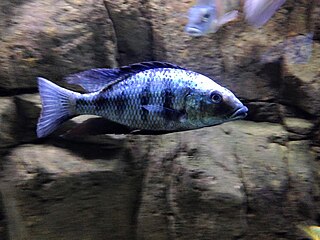
The honey possum or noolbenger, is a tiny species of marsupial that feeds on the nectar and pollen of a diverse range of flowering plants. Found in southwest Australia, it is an important pollinator for such plants as Banksia attenuata, Banksia coccinea and Adenanthos cuneatus.

Passerculus is a genus of birds that belongs to the New World sparrow family Passerellidae. While formerly considered to include just the Savannah sparrow, recent studies by Birdlife International indicate that there 4 species in the genus. Species found in this genus include:
The flathead galaxias is a freshwater fish found in lowland rivers and streams and associated billabongs, backwaters, etc. of the southern Murray-Darling river system in Australia.

The footballfish form a family, Himantolophidae, of globose, deep-sea anglerfishes found in tropical and subtropical waters of the Atlantic, Indian, and Pacific Ocean. The family contains c. 22 species all in a single genus, Himantolophus.

The little sleeper shark is a small sleeper shark of the family Somniosidae found in the northeast Atlantic, western Mediterranean, and western Pacific around New Zealand, at depths between 200 and 1,000 m. Its length is up to 1.43 m.
Handleyomys rostratus, also known as the long-nosed oryzomys, long-nosed rice rat, or rusty rice rat is a species of rodent in the genus Handleyomys of family Cricetidae. It is found in Belize, El Salvador, Guatemala, Honduras, Mexico, and Nicaragua. It is nocturnal and is found in forests at elevations above sea level to 1200 meters. The Handleyomys rostratus attains its highest level of development in south and Central America. High rates of deforestation and habitat destruction are the biggest threat to the Handleyomys rostratus.
The forest soft-furred mouse or West African praomys is a species of rodent in the family Muridae. It is found in Ivory Coast, Ghana, Guinea, and Liberia. Its natural habitats are subtropical or tropical moist lowland forest and subtropical or tropical moist montane forest.
Podocarpus rostratus is a species of conifer in the family Podocarpaceae. It is endemic to Madagascar.

Fossorochromis rostratus is a species of cichlid fish that is endemic to Lake Malawi in East Africa. The only species in its genus, it is a relatively large, sexually dimorphic cichlid.
Siphocampylus rostratus is a species of plant in the family Campanulaceae. It is endemic to Ecuador. Its natural habitat is subtropical or tropical moist montane forests. It is threatened by habitat loss.

The copperband butterflyfish, also known as the beaked coral fish, is found in reefs in both the Pacific and Indian Oceans. This butterflyfish is one of the three species that make up the genus Chelmon and all have long beaks.

The giant kelpfish is a species of clinid native to the west coast of North America, where it is found from California to southern Baja California. It inhabits rocky areas with kelp and other large seaweeds. Its diet consists of small crustaceans, mollusks, and fishes. This species can reach a maximum total length of 61 cm (24 in), and has been reported to live for 4 years. It can also be found in the aquarium trade. It is currently the only known member of its genus.
The frog shark is a very rare species of squaliform shark mainly found in deep water in the Pacific Ocean. It is in the sleeper shark family Somniosidae with the Greenland shark.

Himantolophus groenlandicus, the Atlantic footballfish or Atlantic football-fish, is an anglerfish found primarily in mesopelagic depths of the ocean. Despite its name, this species might not be restricted to the Atlantic Ocean, with its range possibly extending into the Indian Ocean and to the Pacific Ocean. It is found in tropical and temperate regions.
Himantolophus albinares is a species of footballfish, a type of anglerfish. The fish is bathypelagic and can be found at depths ranging from 330 to 1,950 metres. It is endemic to the Atlantic Ocean. As of 1999, a total of four specimens had been found.
Himantolophus brevirostris is a species of footballfish, a type of anglerfish. The fish is bathypelagic and can be found as deep as 3,000 metres (9,800 ft). It is endemic to the north Atlantic Ocean. So far, only males of the species have been found.
Himantolophus compressus is a species of footballfish, a type of anglerfish. The fish is bathypelagic and non-migratory; it can be found in the Atlantic Ocean off the coast of Madeira and southern Portugal.
Himantolophus cornifer is a species of footballfish, a type of anglerfish. The fish is bathypelagic and can be found at depths ranging from 0 to 1,900 metres. It has been found in the Indian, Pacific, and Atlantic Oceans.
Himantolophus crinitus is a species of footballfish, a type of anglerfish. The fish is bathypelagic and has been found at depths of around 610 metres (2,000 ft). It is endemic to the eastern and southeastern central Atlantic Ocean. The species is currently only known from 11 specimens. Females attain a maximum size of 8.3 cm. While males have not yet been recorded, they are likely to be diminutive in comparison to the females, as is common in the family Himantolophidae.
Himantolophus paucifilosus is a species of marine fish of the family Himantolophidae, the footballfishes, a type of anglerfish. The fish is bathypelagic and has been found at depths ranging from 100 to 1,540 metres. It occurs in the east central Atlantic Ocean, from Cape Verde and Senegal in the north to Namibia and Angola in the south, and also on the coast of Brazil.








